Overview
The ADA diet PDF provides a structured approach to healthy eating by emphasizing nutrient-dense foods, portion control, and carbohydrate management to effectively manage blood sugar levels. The article supports this by detailing a step-by-step guide for implementing the diet, including consulting healthcare providers, setting realistic goals, and utilizing resources like meal planning strategies and community support, all aimed at improving overall health and diabetes management.
Introduction
Navigating the complexities of diabetes management can be daunting, but the American Diabetes Association (ADA) diet offers a structured approach that empowers individuals to take control of their health. Centered on balanced nutrition, this dietary framework emphasizes the importance of:
- Nutrient-dense foods
- Effective portion control
- Careful carbohydrate management
By adhering to these principles, individuals can significantly improve their blood glucose levels and reduce the risk of complications associated with diabetes. This article delves into the core components of the ADA diet, provides practical strategies for implementation, and highlights the resources available to support individuals on their journey toward healthier eating and improved well-being.
Understanding the ADA Diet: Principles and Benefits
The American Diabetes Association (ADA) plan, as outlined in the ada diet pdf, centers on a balanced nutritional approach that prioritizes nutrient-dense foods, effective portion control, and careful carbohydrate management. The key principles of this nutritional framework include:
- Nutrient-Dense Foods: Emphasize the consumption of whole grains, fresh fruits, vegetables, lean proteins, and healthy fats. These foods not only provide essential nutrients but also support overall health and weight management. Basing meals around high-fiber foods, such as legumes and whole fruits, is crucial for better health outcomes.
- Carbohydrate Counting: Acquire skills to count carbohydrates accurately, which is vital for maintaining stable blood glucose levels. Understanding carbohydrate content helps individuals make informed choices that directly impact their health, and the ADA diet PDF outlines the significant benefits of adhering to this dietary plan. Enhanced blood glucose regulation is a primary result, with studies showing that adhering to these nutritional guidelines can effectively lower the risk of diabetes-related complications. For instance, excess medical costs associated with diabetes have surged from $10,179 in 2012 to $12,022 in 2022, underscoring the importance of proactive dietary management. According to Cozma et al., based on 18 trials, the isocaloric exchange of fructose for carbohydrates has been shown to reduce glycated blood proteins without significantly affecting fasting glucose or insulin levels, highlighting the importance of understanding carbohydrate sources. Furthermore, a certain organization offers the Diabetes Food Hub® as a valuable resource, providing a selection of free diabetes-friendly recipes, such as low-carb meals and snack ideas, that facilitate healthier eating choices and simplify meal preparation. This platform exemplifies how individuals can incorporate the principles found in the ADA diet PDF into their daily lives while benefiting from the support and education it offers. Additionally, T2DSolutions hosts regular community workshops and webinars, where newly diagnosed patients can connect with healthcare professionals and share experiences, further enhancing their diabetes management journey.
By grasping these principles and utilizing the resources available at T2 Solutions, individuals can make informed nutritional choices that align with their health goals, ultimately improving their quality of life and managing their diabetes effectively, supported by the resources and community connections available at T2 Solutions.
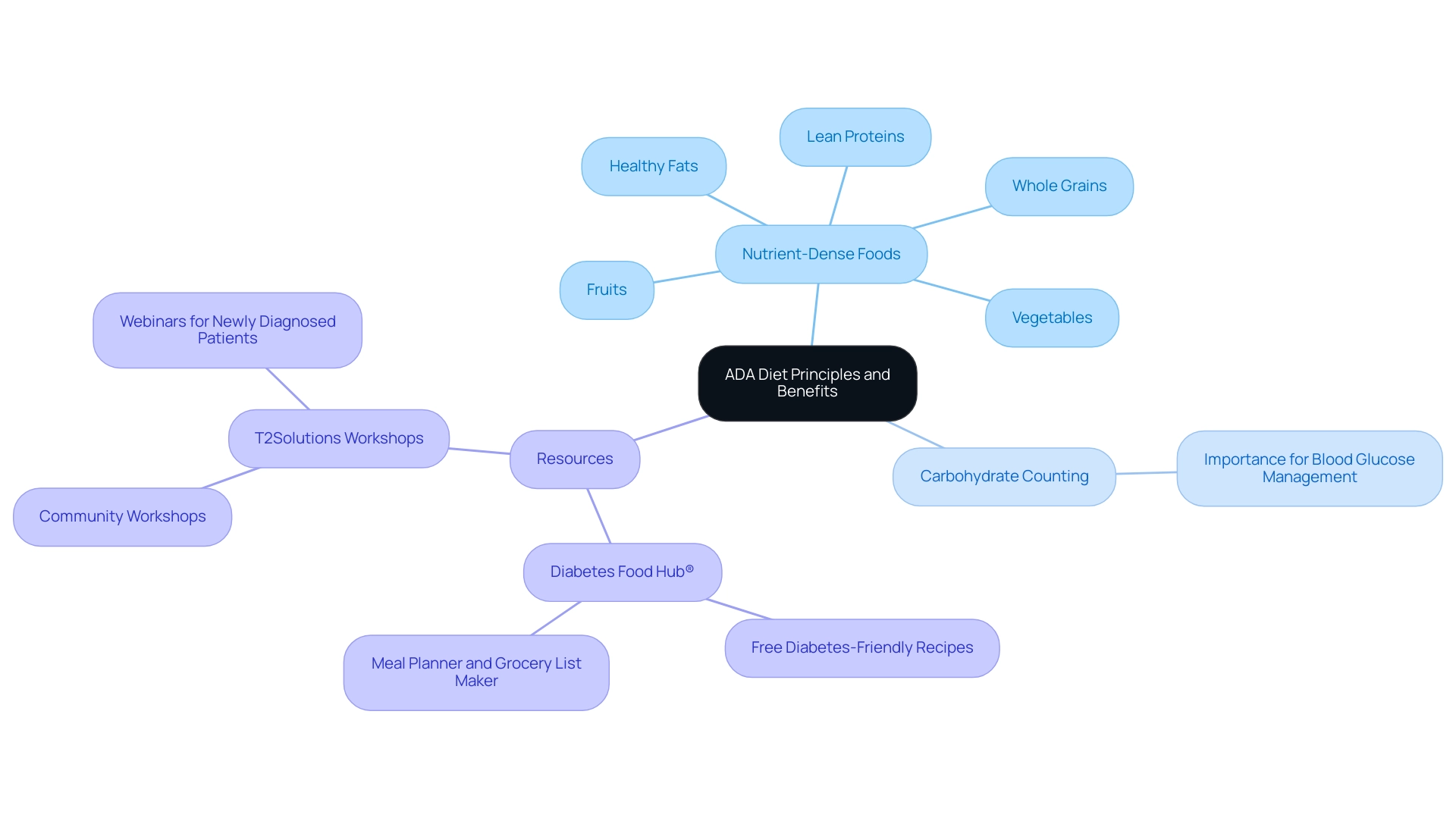
Step-by-Step Guide to Implementing the ADA Diet
To successfully implement the ADA diet, adhere to the following step-by-step guide:
-
Consult with a Healthcare Provider: Before making any changes to your nutrition, it is essential to have a conversation with your doctor or a registered dietitian. Recent studies indicate that healthcare provider (HCP) consultations significantly enhance patient intention to change eating habits, leading to meaningful weight loss outcomes. In a study involving 798 participants with an average age of 39.6 years, the importance of HCP counseling was underscored as it is associated with increased intention to lose weight and actual weight loss.
-
Assess Your Current Eating Habits: Maintain a food diary for one week to accurately track and identify your existing eating patterns. Understanding your habits is a vital first step toward change.
-
Set Realistic Goals: Establish specific, measurable, and achievable nutritional goals. As one expert observes, realistic goal-setting is fundamental for success in dietary modifications, particularly for those managing blood sugar levels. The association between personal characteristics (age, gender, education, marital status, professional status, place of residence, and financial situation) and counseling is crucial to tailor the counseling approach effectively.
-
Create a Balanced Meal Plan: Design a meal plan that includes a diverse range of food groups, emphasizing whole and unprocessed foods. This approach not only supports blood sugar management but also enhances overall health.
-
Practice Portion Control: Utilize measuring cups or a food scale to assist in managing portion sizes effectively. Portion control is essential in maintaining a balanced diet and achieving weight management goals.
-
Monitor Your Blood Sugar: Regularly check your blood glucose levels to gain insights into how different foods impact your health. This practice is essential for modifying your diet and ensuring optimal management of the condition.
-
Stay Educated: Commit to ongoing education about nutrition and diabetes management. Staying updated on the latest discoveries and nutrition guidelines enables you to make informed food choices.
Studies indicate that patients who receive counseling from healthcare providers are more likely to successfully implement changes in their food intake and physical activity levels. For instance, those engaged in HCP counseling reported greater efforts toward weight control and dietary modification. The case study titled "Impact of HCP Counselling on Behavior Change" illustrates that patients who received counseling were more likely to report attempts to control/lose weight and modify their diet, demonstrating the potential effectiveness of HCP counseling in promoting healthier behaviors.
In addition, the company provides a wealth of resources and community support to assist you in effectively navigating the ADA diet PDF. By following this structured approach and utilizing the tools available, you can work towards improved health outcomes.
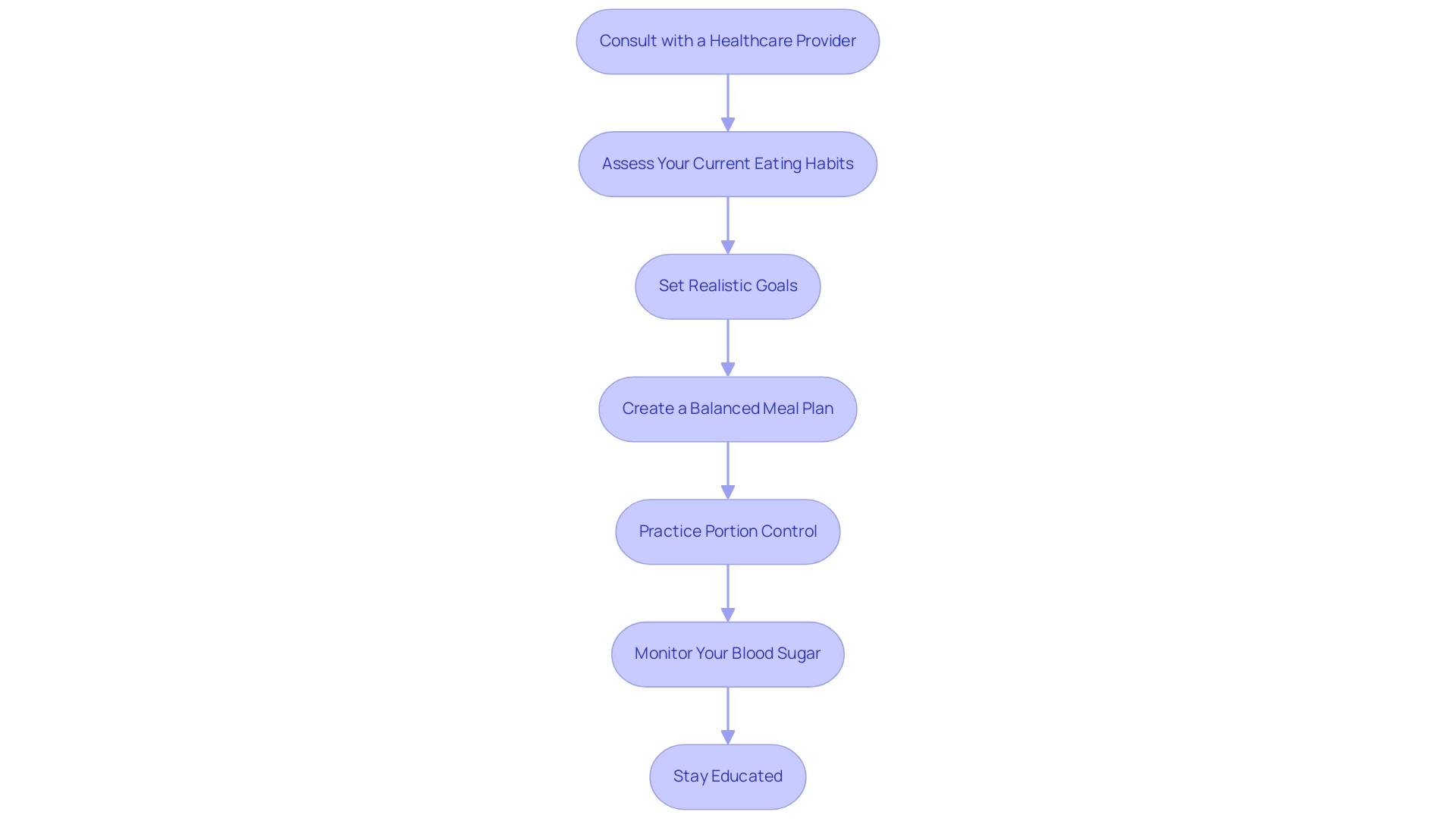
Meal Planning Strategies for Success on the ADA Diet
Efficient dietary planning for individuals managing blood sugar issues, as outlined in the ada diet pdf, is a cornerstone of successful nutritional adherence and overall health results. At T2DSolutions, we acknowledge the significance of these strategies for newly diagnosed individuals and are proud to serve as your all-inclusive resource center for diabetes education and support:
-
Plan Weekly Menus: Allocate time each week to meticulously organize dishes and snacks, ensuring a diverse array of foods that meet nutritional guidelines. This practice is essential for sustaining a balanced diet and can assist in preventing impulsive eating choices.
-
Batch Cooking: Preparing larger portions of nutritious dishes in advance not only saves time during busy weeks but also enables better control over ingredients and portion sizes. Studies indicate that batch cooking is associated with healthier diets and greater adherence to dietary recommendations, especially in individuals who participate in planning their food.
-
Use a Food Planning Template: Develop a structured template that outlines dishes for breakfast, lunch, dinner, and snacks for each day. This organization assists in guaranteeing that all food categories are represented throughout the week and can help simplify grocery shopping.
-
Incorporate Seasonal Ingredients: Utilizing fresh, in-season fruits and vegetables not only enhances flavor but also maximizes the nutritional value of dishes. Seasonal produce often contains higher nutrient levels and supports local agriculture, benefiting both health and community.
-
Stay Flexible: It is essential to remain adaptable with your dining plan to accommodate unexpected events or cravings. This flexibility can prevent feelings of deprivation and contribute to a sustainable eating pattern.
-
Involve Family: Engaging family members in the meal planning process fosters support and shared responsibility, making healthy eating a collective effort. This collaborative approach can enhance compliance with dietary guidelines and foster a more pleasant dining experience.
Effectively managing this condition involves adhering to specific dietary guidelines, such as limiting saturated fatty acids (SFAS) to 7–9% of total daily energy. Furthermore, magnesium intake has been shown to be inversely associated with the risk of Type 2 conditions (T2D), suggesting that ensuring adequate magnesium levels may improve insulin sensitivity and metabolic control. With 463 million adults currently living with high blood sugar, as noted in the 2019 Diabetes Atlas, effective dietary planning strategies become even more crucial in managing this condition and reducing the risk of related illnesses.
According to USDA guidelines, adopting structured food planning can help avoid overweight and obesity, ultimately reducing the risk of heart disease, diabetes, and cancer. As Robert H. Shmerling, MD, emphasizes, 'Studying the impact of dietary (or any other) recommendations is an important way to validate the guidelines’ usefulness.' The advantages of food preparation are further supported by a cross-sectional study titled 'Food Planning and Diet Quality,' which found that planning is associated with a healthier diet, higher adherence to nutritional guidelines, and lower odds of being overweight and obese, particularly in women.
Thus, applying these efficient meal planning techniques, together with the resources offered at this service and the guidelines from the ada diet pdf, can act as a foundation in the management of blood sugar levels.
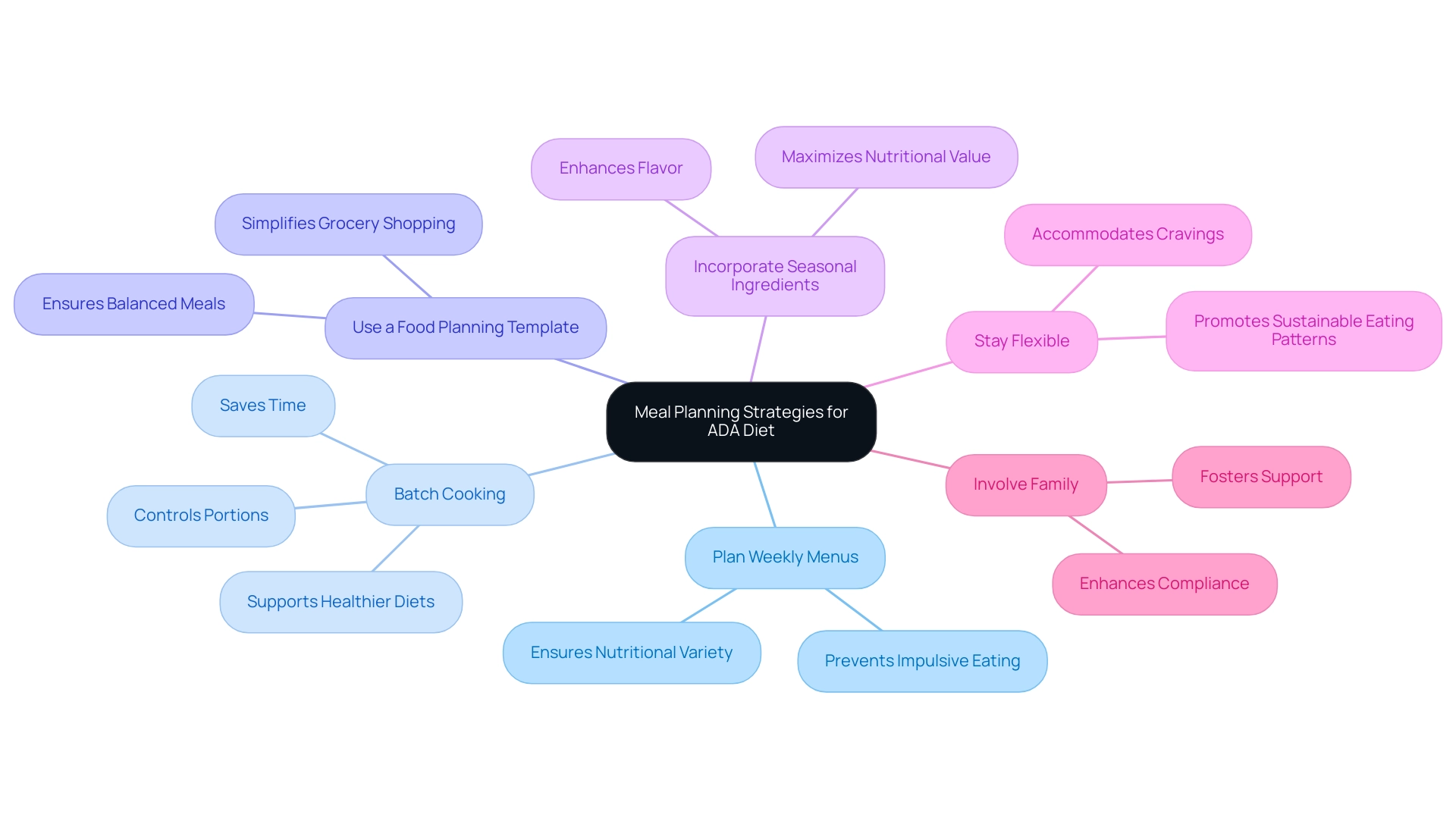
Navigating Social Situations on the ADA Diet
Successfully navigating social situations while following the ADA diet PDF requires thoughtful planning and open communication. As the organization prepares to launch, it will serve as a valuable resource hub for newly diagnosed patients seeking support and information on diabetes management. Here are some strategies to consider:
-
Communicate Your Needs: It is essential to inform friends and family about your dietary preferences well ahead of time.
This proactive approach fosters understanding and support, a principle that the organization aims to reinforce through community engagement. -
Choose Wisely: When dining out, select restaurants that offer nutritious options and flexibility to personalize your dish. This choice is crucial, especially as studies show a correlation between increased dining out and the risk of poor diet quality and weight gain. The company will provide a list of recommended restaurants and meal options to assist you in making informed choices.
-
Practice Portion Control: Being mindful of portion sizes is critical when eating out or at social gatherings. This practice can significantly impact blood sugar management, a focus area for the organization in providing educational resources. Expect to find tools and guides on portion control on our site.
-
Bring a Dish: If you are invited to a potluck or gathering, consider bringing a healthy dish that aligns with the ADA guidelines. This not only ensures you have something suitable to eat but also introduces others to healthy options. The platform will feature recipes that are both delicious and compliant with the guidelines outlined in the ADA diet PDF.
-
Stay Mindful: Focus on enjoying the company rather than solely the food. This shift in perspective can help mitigate the temptation to overeat, a concept that will be further explored through upcoming content, including articles and tips on mindful eating.
-
Plan for Treats: Allow yourself occasional treats without guilt by balancing them with healthier choices throughout the week. Savoring a sweet indulgence occasionally can be integrated into your diet by reducing carbs during times of eating and sharing desserts. T2DSolutions will provide strategies for incorporating treats into your dining plan without compromising your health goals, as detailed in the ADA diet PDF.
As Dariush Mozaffarian, a prominent expert in this field, notes,
At restaurants, two forces are at play: what’s available on the menu, and what Americans are actually selecting.
This underscores the importance of being informed and intentional in your dining choices. Furthermore, the results from the research on dishes prepared at home indicate that such habits may lower the risk of type 2 blood sugar issues, highlighting the importance of home cooking in a society focused on eating out.
Significantly, the correlation coefficient of 0.97 between self-reported and measured body weight emphasizes the importance of precise tracking of food intake for effective weight management. This strengthens the important link between dishes made at home and the risk of type 2 health issues, clarifying that home-cooked dishes can have a substantial impact on managing nutritional health.
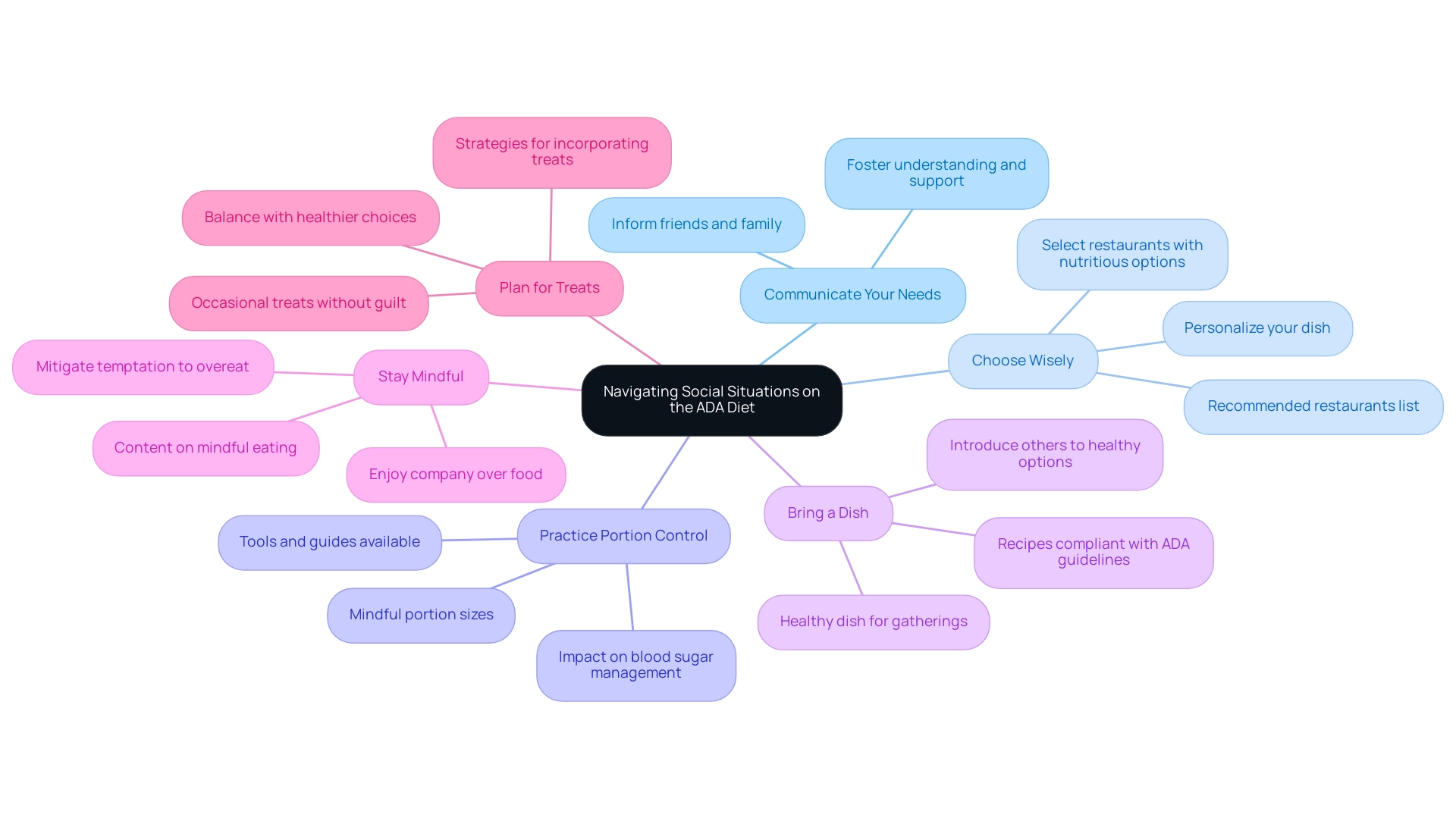
Monitoring Progress and Adjusting Your ADA Diet
To effectively monitor your progress and make necessary adjustments to your ADA meal plan, consider the following strategies:
-
Keep a Food Journal: Documenting your meals, portion sizes, and your feelings post-consumption can help identify eating patterns that affect your blood sugar levels. Research indicates that 90% of study participants who engaged in diabetes education benefited from food journaling, highlighting its critical role in diabetes management. Moreover, consistent trackers lost an average of 10 pounds, emphasizing the effectiveness of this practice.
-
Regularly Check Blood Sugar Levels: Consistent monitoring of blood glucose levels is essential for understanding how specific foods impact your body. A study revealed that participants who maintained a food journal and tracked their caloric and fat intake did not experience weight gain during the holidays, suggesting that regular tracking serves as a protective factor against nutritional challenges. The Statistical Modeling of Weight Change study further supports this, showing that consistent tracking significantly predicted weight change, explaining 15.31% of the variance in final weight loss.
-
Review Goals Periodically: It is advisable to assess your dietary goals on a monthly basis and make adjustments based on your progress. This iterative process allows for flexibility and responsiveness to your evolving health needs.
-
Seek Professional Guidance: Regular consultations with your healthcare provider or dietitian are crucial. They can offer tailored advice and help you navigate any challenges you face in adhering to the guidelines provided in the ada diet pdf. As one participant noted, > If you report everything... that is where the tedium comes in, where you’re trying to count every little, tiny, nit-picky thing <. This highlights the potential difficulties in tracking, emphasizing the importance of professional guidance to simplify the process.
-
Be Flexible: Recognize that adjustments to your regimen may be necessary as your lifestyle, preferences, and health needs change over time. The analysis from the Statistical Modeling of Weight Change study indicated that consistent tracking significantly predicted weight change, underscoring the importance of adaptability in managing diabetes effectively.
While the current context regarding T2DSolutions is unknown, it is anticipated that once launched, T2DSolutions will provide valuable resources related to ADA guidelines, further supporting individuals in their diabetes management journey.
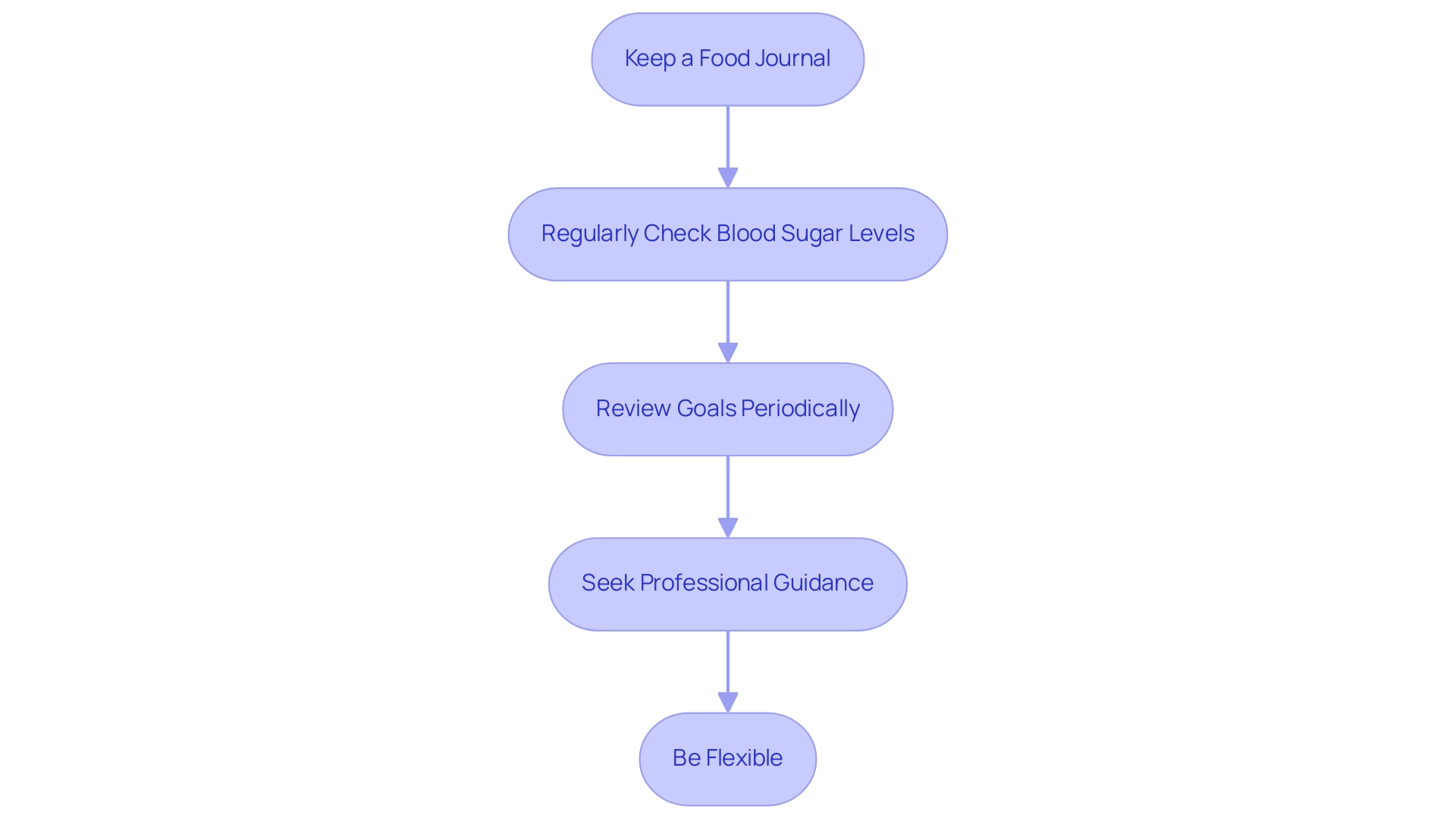
Conclusion
Adhering to the American Diabetes Association (ADA) diet presents individuals with a structured pathway to effectively manage diabetes through balanced nutrition. The core principles of the diet—focusing on nutrient-dense foods, mastering portion control, and practicing careful carbohydrate management—are essential for stabilizing blood glucose levels and minimizing the risk of complications.
Implementing the ADA diet involves a methodical approach, beginning with:
- Consultations with healthcare providers
- Assessing current eating habits
Setting realistic goals and utilizing meal planning strategies can further enhance adherence and promote healthier eating patterns. Resources such as T2DSolutions offer invaluable support, providing educational tools and community engagement to empower individuals on their health journey.
As individuals navigate social situations and monitor their dietary progress, the importance of:
- Communication
- Mindful eating
- Regular blood sugar checks
cannot be overstated. By being proactive and adaptable, individuals can successfully integrate the ADA diet into their daily lives, fostering a sustainable and health-conscious lifestyle.
Ultimately, the ADA diet not only aids in managing diabetes but also contributes to overall well-being. By embracing these dietary principles and utilizing available resources, individuals can take significant steps toward improving their health outcomes and enhancing their quality of life.



